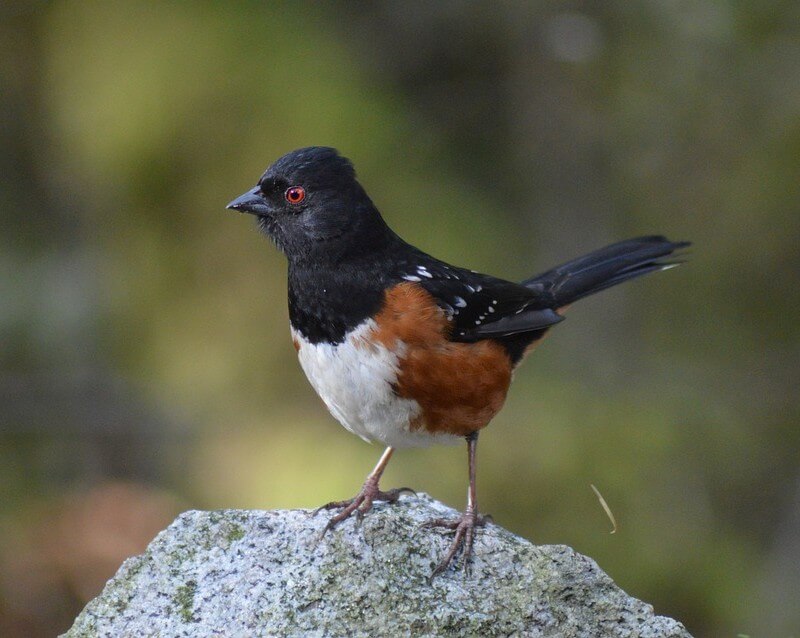From Salt Lake City to Dixie National Forest, the Beehive State is home to some amazing birds. With 469 species observed on ebird, Utah’s changing seasons and vast geography provide for a diverse habitat. In this post we’ll review 30 of the most common and colorful birds in Utah along with some helpful data on when and where to find them.
We even sampled 5 years of aggregate data from ebird’s Utah checklists to compile easy-to-use statistics and graphs to help identify each bird species. So whether you’re just watching the backyard bird feeder or venturing to birding hotspots like Fish Springs National Wildlife Refuge or Tonaquint Nature Center – we’ll have you ready to start bird watching like a professional.
American Goldfinch
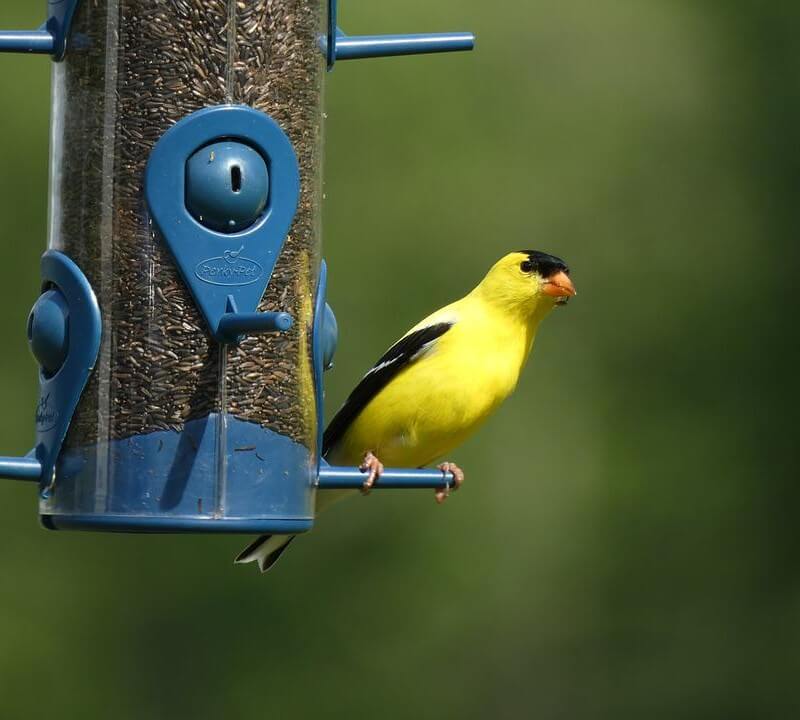
The American Goldfinch is a small finch with a short tail, widespread throughout North America.
- Carduelis tristis
- Size: 5″ (13cm)
- UT Checklist Frequency High: 19% in November
- UT Checklist Frequency Low: 7% in March
Identification and Color: A fan favorite at backyard feeders for its brilliant yellow color. A small, slim finch with a small bill and rounded wings. The back is black with white wing bars. Underparts are yellow with a black bill. The tail is white with black markings on the outer feathers.
Habitat and Behavior: The American Goldfinch nests and breeds in open woodlands, meadows, and fields. Commonly seen in gardens and parks. During the breeding season, the American Goldfinch is often seen in flocks. Known to hang upside down from branches while feeding. Typically nests late in the summer.
Diet: Strict vegetarian. The American Goldfinch feeds on tiny seeds, weeds and grasses. Enjoys nyjer and sunflower seeds. Rarely consumes insects.
American Kestrel

The American Kestrel can be seen year-round in Utah.
- Falco sparverius
- Size: 9″ (23cm)
- UT Checklist Frequency High: 20% in December
- UT Checklist Frequency Low: 6% in July
Identification and Color: Known as the smallest falcon. They have intricate patterns and multiple colors. Their bodies are covered with black spots. The male’s body has a top color of rusty red, then a grey or blue strip, then white. A female is red and white without the blue-grey stripe. Both sexes have black slash marks on their heads.
Habitat and Behavior: Found throughout the United States and some parts of Canada. Their habitat can vary but they prefer open spaces and perching high up above the ground. Will often spot prey from their high perch and swoop down on it.
Diet: The American Kestrel will feed on large insects such as grasshoppers or beetles. They will also catch small mammals or reptiles.
American Robin
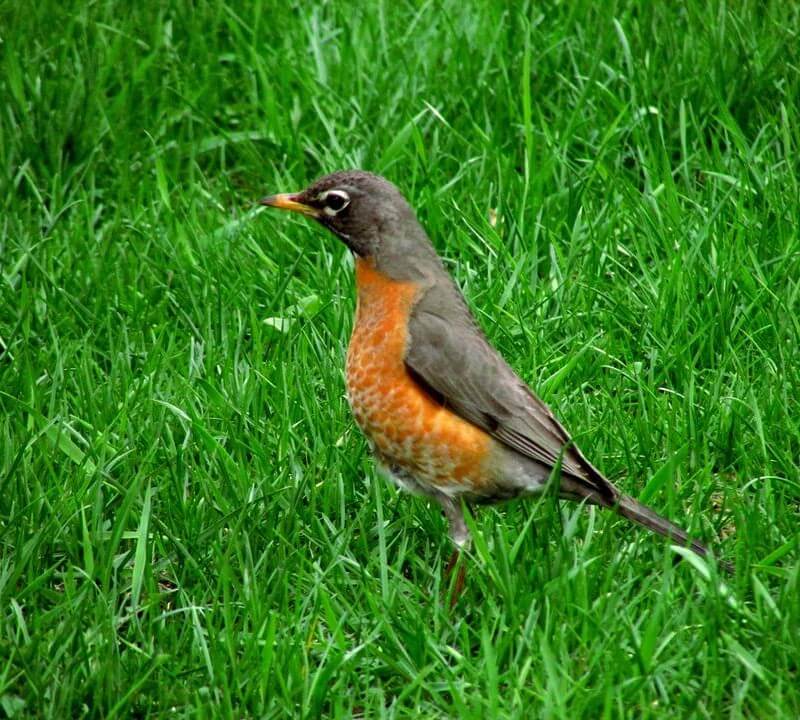
Abundant throughout the entire country and commonly a welcome indicator of spring in northern states. The American Robin is a common sight in Utah.
- Turdus migratorius
- Size: 9-11″ (22.5-28cm)
- UT Checklist Frequency High: 55% in June
- UT Checklist Frequency Low: 21% in August
Identification and Color: Reddish-brown breast (almost looks pot-bellied) and grey back. The female usually has a lighter plumage than the male. Males have a darker black head.
Habitat and Behavior: The American Robin is found in open woodlands, gardens, and parks. It often forages for food on the ground cocking its head to the side in an effort to find worms. When it’s not eating, the American Robin can often be seen perched on a branch singing its cheerful song.
Diet: The American Robin feeds on insects, worms, berries, and fruits.
Barn Swallow

The Barn Swallow is a small common songbird that is often seen swooping in flight. Typically found in Utah during the summer months.
- Hirundo rustica
- Size: 7″ (17 cm)
- UT Checklist Frequency High: 30% in August
- UT Checklist Frequency Low: 0% in Winter
Identification and Color: Easily identified by its long forked tail. Has a shiny blue hood and back with orange underparts.
Habitat and Behavior: Found in fields and meadows, specifically for foraging. Can also be seen near lakes and ponds. These birds are attracted to barns and other buildings because they provide a safe place to build their nests. These birds are known for their aerial acrobatics and often perform flips and twists while flying.
Diet: The Barn Swallow feeds on insects, which it often catches in mid-air. Can also be seen skimming the water’s surface for a drink.
Black-billed Magpie

The Black-billed magpie can be seen year-round in Utah.
- Pica hudsonia
- Size: 24″ (61 cm)
- UT Checklist Frequency High: 36% in December
- UT Checklist Frequency Low: 14% in July
Identification and Color: Black-billed magpies have black heads with two white patches along the body and blue-green iridescent wings. In flight, the white tips and blue-green colors make a striking image. Very long tail feathers and thick short bills. Fairly large bird between 17 and 24 inches in length.
Habitat and Behavior: Found in the upper northwest and into Canada. A social bird that can be found in large groups. Likes farmland, forest edges, and other semi-open areas. Generally does not migrate far if at all. Will forage on the ground.
Diet: The Black-billed magpie is omnivorous with a varied diet. Enjoys insects, carrion, berries, and seeds.
Black-capped Chickadee

Black-capped Chickadees are small songbirds commonly found at feeders and nest boxes. Year-round residents of Utah.
- Poecile atricapillus
- Size: 5.5″ (14 cm)
- UT Checklist Frequency High: 32% in December
- UT Checklist Frequency Low: 15% in June
Identification and Color: Easily distinguished by their black caps and white cheeks. They have grey bodies with light grey wings and tail feathers.
Habitat and Behavior: Typically inhabit woodlands where there are plenty of trees for them to nest and forage in. Commonly found in suburban areas and parks. Has no issue with harsh winters. Black-capped Chickadees are not timid birds and can easily be attracted to backyard bird feeders
Diet: Consists mainly of insects and other small invertebrates like caterpillars. Chickadees will also eat seeds and berries, especially in the winter months when food is scarce.
California Quail

The California Quail is a year-round resident of Utah.
- Callipepla californica
- Size: 11″ (28 cm)
- UT Checklist Frequency High: 12% in May
- UT Checklist Frequency Low: 5% in January
Identification and Color: Male and female California Quail have some key differences. Males are grey and brown with black faces and white stripes outlining their faces. Females are lighter brown with no face markings. Both sexes have white and tan scales on their bellies. The most distinct feature between both is a comma-shaped crest on their heads.
Habitat and Behavior: The California Quail is common in California and north of the state. They will stay year-round in the area. Found in woodlands and foothill forests. Can be found in large groups and will forage on the ground.
Diet: A diet based mostly on seeds and leaves. Will eat many different plants, acorns, and berries.
Cedar Waxwing

The Cedar Waxwing can be seen in Utah year-round.
- Bombycilla cedrorum
- Size: 7.5″ (19 cm)
- UT Checklist Frequency High: 7% in November
- UT Checklist Frequency Low: 2% in April
Identification and Color: These birds truly have a variety of colors. A brown head, but with a black line across the eyes outlined in white. A dark grey top meets darker colors on the wings and tail feathers. Pale yellow belly. Red tips on their wings and bright yellow tip at the end of their tails. A short square tail and short wide bill.
Habitat and Behavior: Found in many different areas and moves around irregularly. Likes to be around woodlands, especially fruiting trees or farm orchards. Very social and can be seen in large flocks.
Diet: The Cedar Waxwing prefers berries and small fruits but will also eat some insects.
Chipping Sparrow

The Chipping Sparrow is a small bird native to North America and seen year-round in Utah.
- Spizella passerina
- Size: 5.5″ (14 cm)
- UT Checklist Frequency High: 16% in June
- UT Checklist Frequency Low: 1% in Winter
Identification and Color: Small and slender bird, measuring only about five and a half inches in length. Its body is brown and white, with a dark eye line extending from the beak past the eye.
Habitat and Behavior: The Chipping Sparrow can be found in open woodlands, suburbs, parks, farmland and backyards. Known to forage on the ground for seeds. Easy to mix up with other sparrows, the Chipping Sparrow loves open areas with scattered trees making it a common sight at feeders.
Diet: Primarily insects when available (mainly summer months). Enjoys finding seeds in the grass.
Cliff Swallow

The Cliff Swallow can be seen during the summer months in Utah.
- Petrochelidon pyrrhonota
- Size: 6″ (15 cm)
- UT Checklist Frequency High: 20% in June
- UT Checklist Frequency Low: 0% in Winter
Identification and Color: The Cliff Swallow has a brown head with black at the very top and a white forehead patch. In proper light, their backs will have a metallic shine on their dark blue feathers. White underparts with brown wings and tails. Rounded wings and a medium-length tail. They have a very short, pointed bill.
Habitat and Behavior: Breeds all over the United States, Canada, and up to Alaska. A very long-distance migrant bird that will go all the way to southern South America. Will build their nests on upright surfaces like cliffs, bridges, or culverts. Will catch insects on wings for foraging.
Diet: The Cliff Swallow enjoys a wide variety of insects, including many flying insects such as bees, wasps, and flies. They will occasionally eat berries.
Dark-eyed Junco

The Dark-eyed Junco is a small, sparrow-like bird that is one of Utah’s most common winter birds.
- Junco hyemalis
- Size: 6″ (15 cm)
- UT Checklist Frequency High: 61% in December
- UT Checklist Frequency Low: 4% in May
Identification and Color: Rounded dark head and eyes. Charcoal back and white breast.
Habitat and Behavior: Enjoys a variety of wooded habitats throughout Canada and the northern United States. Dark-eyed Juncos are typically found in open woods, forest edges, weedy fields, and backyards. In winter they often form flocks and can be seen feeding on the ground beneath bird feeders.
Diet: Dark-eyed Juncos eat mostly insects and seeds.
Downy Woodpecker

The Downy Woodpecker can be seen year-round in Utah.
- Picoides pubescens
- Size: 6″ (15 cm)
- UT Checklist Frequency High: 17% in December
- UT Checklist Frequency Low: 5% in May
Identification and Color: Adult Downies are black and white, with a black back, white belly, and a small patch of red on the back of the head. They have a short bill and a barred tail.
Habitat and Behavior: Downy Woodpeckers live in forests, woodlands, orchards, and suburban areas. They are year-round residents in most of their range. They forage on tree trunks and branches, using their bills and barbed tongue to peck at bark to find food.
Diet: Downies feed on insects, spiders, berries, and nuts. Downies sometimes store food by caching it in cracks in trees or other hidden spots. Can be spotted at seed and suet feeders.
Eurasian Collared-Dove

The Eurasian Collared-Dove is most often seen during the summer months in Utah.
- Streptopelia decaocto
- Size: 13″ (33 cm)
- UT Checklist Frequency High: 27% in February
- UT Checklist Frequency Low: 17% in October
Identification and Color: The Eurasian Collared-Dove has a light grey to brown head and a light brown body. They have a distinct black mark around the back of their neck and some white patches on their tail. They have rounded bodies and small heads. Rounded wings and squared tails. Their bills are slender with a slight curve.
Habitat and Behavior: Found all over the United States with no consistent migration. Can be found in urban areas and open farmland as well. When walking they can be seen bobbing their heads and flicking their tails. Will mainly forage on the ground.
Diet: The Eurasian Collared-Dove enjoys seeds from plants and waste grain. Will also eat some berries or insects.
European Starling

The European Starling is native to Europe but was introduced to North America in the late 1800’s. Considered an invasive species, they are a common backyard bird in Utah.
- Sturnus vulgaris
- Size: 8.5″ (22 cm)
- UT Checklist Frequency High: 37% in January
- UT Checklist Frequency Low: 13% in July
Identification and Color: Small, stocky black birds with glossy feathers and a slender pointed bill. Speckled with white spots.
Habitat and Behavior: European starlings can be found in woods, fields, and other open areas. They often build their nests in trees or holes in buildings. European starlings are also known for their elaborate vocalizations, often imitating the sounds of other birds.
Diet: European starlings are opportunistic eaters and will feed on a variety of insects, fruits and seeds.
House Finch

The House Finch is a common bird across North America, seen year-round in Utah.
- Carpodacus mexicanus
- Size: 5″ (13 cm)
- UT Checklist Frequency High: 44% in December
- UT Checklist Frequency Low: 28% in July
Identification and Color: Fairly small, measuring only about 5-6 inches long. House Finches are relatively easy to identify thanks to their characteristic red plumage near the eyes and throat. Males are typically redder than females, but both genders have distinctive streaks on their breast and belly.
Habitat and Behavior: House Finches are found in a variety of habitats, including woods, gardens, and open fields. A rather social bird that often travels in flocks. Can often be seen perching on power lines or fences in suburban areas.
Diet: House Finches are primarily seed eaters, but they will also consume insects and fruit on occasion.
House Sparrow

One of the most common backyard birds in Utah. The House Sparrow is seen year-round.
- Passer domesticus
- Size: 6″ (15 cm)
- UT Checklist Frequency High: 31% in December
- UT Checklist Frequency Low: 17% in September
Identification and Color: A small plump bird with brown feathers and a grayish-plain breast. They have a black stripe on their face that extends from their bill to their throat. Wings are streaked with black and white.
Habitat and Behavior: Found in open areas with some trees nearby, such as farmland, parks, and suburban neighborhoods. They build their nests in holes in tree trunks or in man-made structures such as gutters, light fixtures, and nest boxes. House Sparrows are social birds that often form large flocks. You won’t be surprised to see them downtown near restaurants with outdoor seating!
Diet: House Sparrows eat mostly seeds and grains, but will also eat insects, berries, and other fruits. Happy to pick up crumbs and left over human food where available.
Lesser Goldfinch

The Lesser Goldfinch is a year-round resident of Utah.
- Spinus psaltria
- Size: 5″ (13 cm)
- UT Checklist Frequency High: 21% in August
- UT Checklist Frequency Low: 12% in January
Identification and Color: Males have black on top of their heads and bodies. They have a bright yellow underpart and white bars on their wings. Females have a dark top, but not black and yellow underparts that are duller than the males. These birds have short tails and long wings. They have a very short bill.
Habitat and Behavior: Found in the southern midwest and west. Mostly permanent residents in their locations, but northern birds may migrate further south. Likes to be in weedy fields, brushy areas, and can be close to streams. Can be in extremely large groups and may mix with other bird species.
Diet: The Lesser Goldfinch will eat mostly seeds but some insects too.
Mountain Chickadee

The Mountain Chickadee can be seen year-round in Utah.
- Poecile gambeli
- Size: 6″ (15 cm)
- UT Checklist Frequency High: 12% in August
- UT Checklist Frequency Low: 3% in May
Identification and Color: The Mountain Chickadee has a black and white head with gray on top of the body and underparts. Males and females look similar. The main identifier of the Mountain Chickadee is the white strip above the eye. They have narrow tails and rounded wings with a small and pointed bill.
Habitat and Behavior: Permanent residents of the southwest and northwest. Prefers forests that are mostly dry and mountainous. They like evergreens and high areas but can move to the lower levels in the winter. Very active and will jump around in their trees. Will join flocks of other birds when foraging in trees.
Diet: Mountain Chickadees enjoy a diet of insects, seeds, and berries. They will usually eat the insect eggs and pupae.
Mourning Dove
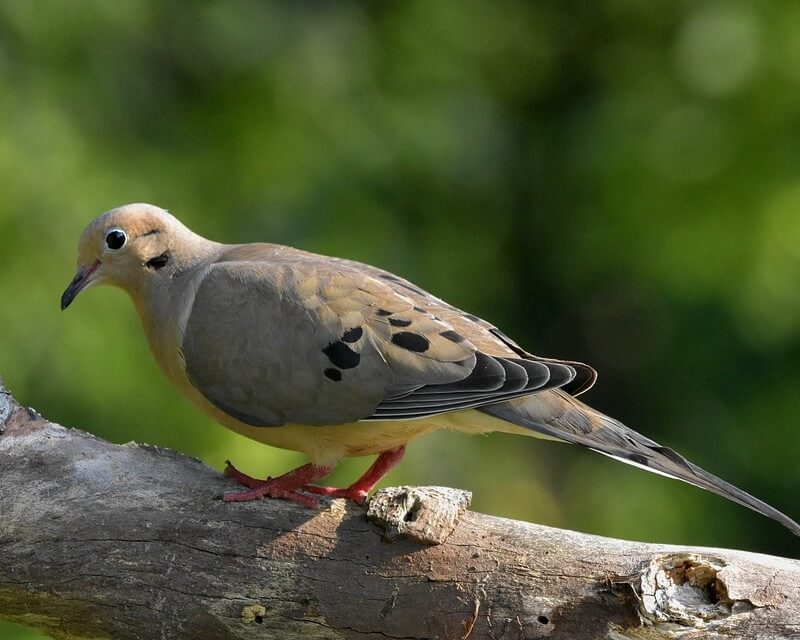
Mourning Doves are one of the most common birds in North America, and they can be found in a variety of habitats throughout Utah.
- Zenaida macroura
- Size: 12″ (30 cm)
- UT Checklist Frequency High: 36% in May
- UT Checklist Frequency Low: 9% in January
Identification and Color: These slender birds have long, pointed tails and a tiny head. Brown and pale gray plumage with darker streaks on the wings and back.
Habitat and Behavior: Mourning Doves are relatively quiet birds, but they can often be heard cooing softly. Mourning Doves typically nest in trees, but they will also use man-made structures such as window ledges and gutters.
Diet: The Mourning Dove primarily eat seeds, but they will also eat insects and berries
Northern Flicker
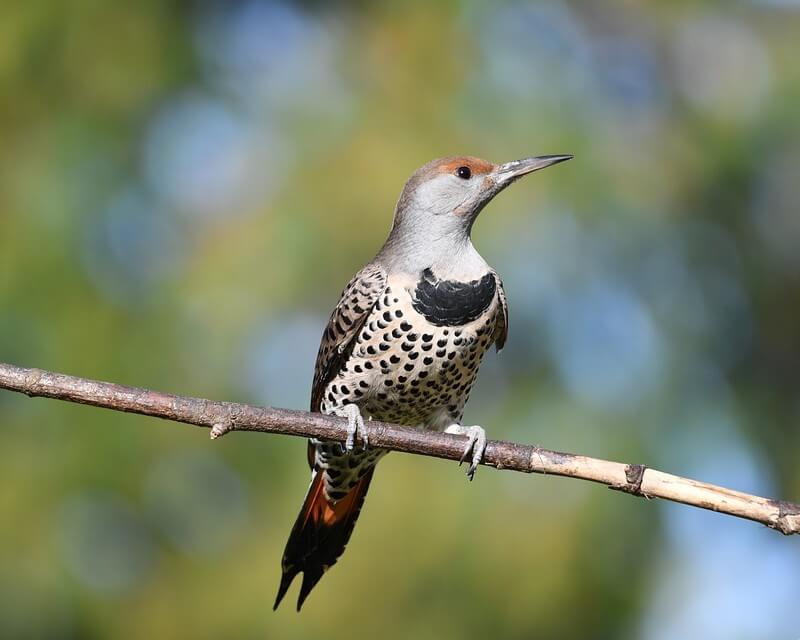
The Northern Flicker is seen year-round in Utah.
- Colaptes auratus
- Size: 12″ (30 cm)
- UT Checklist Frequency High: 42% in October
- UT Checklist Frequency Low: 10% in May
Identification and Color: A fairly common large woodpecker, but size is where the similarities to other woodpeckers end. The male Northern Flicker is unique with a brown back, black bars and spotted breast. All North American Flickers have white rumps. There are also two different color groups of Northern Flickers – Yellow-shafted and Red-shafted. Yellow-shafted flickers have yellow underwings. Red-shafted flickers have reddish pink underwings.
Habitat and Behavior: Northern Flickers are hole-nesting birds, often making a home in a dead tree. Can be seen hopping around the ground while foraging or latched onto a tree eyeing a spot to search for food.
Diet: Northern Flickers mainly eat insects off the ground, but will also eat berries and nuts.
Pine Siskin

The Pine Siskin is seen year-round in Utah.
- Spinus pinus
- Size: 5″ (13 cm)
- UT Checklist Frequency High: 15% in July
- UT Checklist Frequency Low: 5% in September
Identification and Color: The Pine Siskin is brown with black streaks all over its body. They have some yellow edges on their wings and tails. Very small birds between 4 and 5 inches in length. They have short notched tails. Their bills are sharp, short, and pointed.
Habitat and Behavior: Pine Siskins have a very odd migration and residency. Some will breed in the very far north, some will winter throughout the United States, and some are permanent residents along the United States and Canada border. Will primarily be in evergreen forests but can be found in other areas of thickets or weedy areas. Will forage in large flocks.
Diet: Seeds, vegetable matter, and some insects. Will feed on the tree, grass, and weed seeds.
Red-breasted Nuthatch

The Red-breasted Nuthatch is a year-round resident of Utah.
- Sitta canadensis
- Size: 4.5″ (11 cm)
- UT Checklist Frequency High: 11% in August
- UT Checklist Frequency Low: 3% in April
Identification and Color: These birds have a black patch at the top of their head and a black stripe over their eyes, with white in between the black on the head. The top of their bodies is a blue grey. In males the underparts are a strong reddish brown, females are paler in their colors. They are small birds with short tails and short, broad wings. They have long and pointed bills.
Habitat and Behavior: Some remain permanent residents throughout Canada and some migrate south into the United States for winter. Can be found in either coniferous or deciduous forests along mountainous areas as well. Forages by quickly moving around trees.
Diet: The Red-breasted Nuthatch mainly eats insects during the summer and seeds in the winter.
Red-winged Blackbird

The Red-winged Blackbird is a year-round resident of Utah, especially near areas of water.
- Agelaius phoeniceus
- Size: 8.5″ (22 cm)
- UT Checklist Frequency High: 32% in May
- UT Checklist Frequency Low: 11% in August
Identification and Color: A small black bird with a striking appearance. The male has black feathers and a red patch on each wing, while the female is mostly dark brown with vertical streaks.
Habitat and Behavior: These birds are found in open areas such as marshes, meadows, and fields. Often seen near water, where they build their nests. Red-winged Blackbirds are social birds and often form large flocks.
Diet: The Red-winged Blackbird diet consists of insects, spiders, and other small invertebrates. Will also eat seeds, fruits, and berries.
Ruby-crowned Kinglet

The Ruby-crowned Kinglet is commonly seen in Utah during the spring and fall months.
- Regulus calendula
- Size: 4″ (11 cm)
- UT Checklist Frequency High: 20% in October
- UT Checklist Frequency Low: 3% in August
Identification and Color: The Ruby-crowned Kinglet has an olive green body with somewhat lighter underparts. They have white eye-rings and on males, the ruby red crest is only occasionally able to be seen. White and black wing bars. They are small birds with large heads and no necks. Very thin and straight bills.
Habitat and Behavior: Will breed very far north and migrates to spend the winter in the south. They like to be in tall and dense forests. Favor coniferous in the summer and deciduous in the winter because of their location. Very energetic birds that are constantly flicking their wings. They forage at many levels in the trees.
Diet: In summer the Ruby-crowned Kinglet feeds mainly on insects. During winter they will eat some berries and seeds.
Song Sparrow

The Song Sparrow is a small bird commonly found during warmer months in Utah.
- Melospiza melodia
- Size: 6″ (15 cm)
- UT Checklist Frequency High: 29% in December
- UT Checklist Frequency Low: 14% in August
Identification and Color: The Song Sparrow is brown and gray in color with streaks on its breast and a grayish-brown back. Gets its name from its loud melody.
Habitat and Behavior: Can be found in a variety of habitats including forests, grasslands, and wetlands. The Song Sparrow is a relatively shy bird, but will happily visit bird feeders if food is available.
Diet: Song Sparrows primarily eat insects, but will also eat seeds and berries.
Spotted Towhee

The Spotted Towhee can be seen during the warmer months in Utah.
- Pipilo maculatus
- Size: 8″ (20 cm)
- UT Checklist Frequency High: 21% in December
- UT Checklist Frequency Low: 6% in August
Identification and Color: Males have black upperparts with spotted white on their backs. Females are gray-brown with the same spot pattern on their backs. Both sexes have a red-brown patch with white bellies. They have long rounded tails with white tips. Thick and pointed bills.
Habitat and Behavior: Found mainly in the Great Plains and the west half of the United States. Birds in the central north often migrate, and many are permanent residents of the south and west. Like to be in open areas that have a lot of shrubs and thick undergrowth. Mainly forages on the ground.
Diet: The Spotted Towhee eats insects, seeds, and berries. Their diet is dependent on the season with insects being eaten in the summer and seeds and berries in the winter.
Steller’s Jay
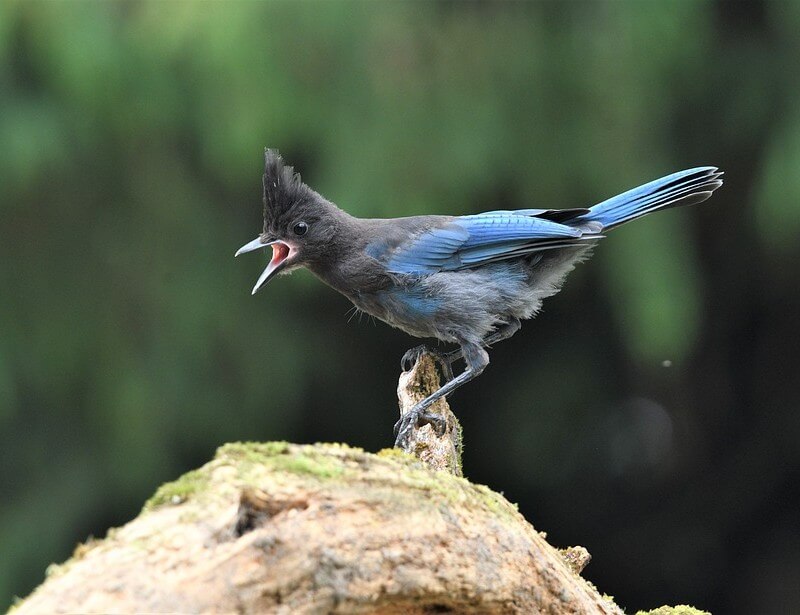
The Steller’s Jay is a year-round resident of Utah.
- Sayornis saya
- Size: 7″ (18 cm)
- UT Checklist Frequency High: 8% in August
- UT Checklist Frequency Low: 3% in May
Identification and Color: Steller’s Jay can have either blue or white streaks on the front of their face depending on the region. They have a long and triangular crest that is black and gray patch that leads to blue bodies. They have rounded wings and long tails. A long and straight bill with a slight hook.
Habitat and Behavior: Permanent residents in their western locations, with only some moving if in high elevations. Found in evergreen forests they can also be in some more populated areas. Mostly forages high in the trees but will occasionally forage lower or on the ground.
Diet: Steller’s Jays are omnivorous. They eat mostly vegetarian with some insect and animal matter mixed into their diet.
Woodhouse’s Scrub-Jay

The Woodhouse’s Scrub-Jay can be seen year-round in Utah.
- Aphelocoma woodhouseii
- Size: 12″ (30 cm)
- UT Checklist Frequency High: 22% in October
- UT Checklist Frequency Low: 9% in June
Identification and Color: Woodhouse’s Scrub-Jay is a long bird with long tail feathers. They are blue and grey on top, with a white throat and grey underparts. Their bill is straight and pointed.
Habitat and Behavior: Prefers open areas of pinyon or juniper. May also be in suburban regions of the mid-southwest. These vocal birds often perch in high places. They may forage alone or in flocks.
Diet: The Woodhouse’s Scrub Jay is omnivorous and will eat insects, seeds, and nuts. Will eat spiders and snails and often feed caterpillars to their young.
Yellow Warbler

The Yellow Warbler calls Utah home from spring to fall before migrating for the winter.
- Dendroica petechia
- Size: 5″ (13 cm)
- UT Checklist Frequency High: 38% in May
- UT Checklist Frequency Low: 0% in Winter
Identification and Color: A small warbler that is often mistaken for the American Goldfinch. Males have orange streaking on the chest area while females are a bit duller with a grayish yellow.
Habitat and Behavior: A common backyard bird during the summer months that likes gardens, shrubs, and thickets.
Diet: The Yellow Warbler enjoys a steady diet of insects.
Yellow-rumped Warbler

The Yellow-rumped Warbler is most commonly seen in Utah during the spring and fall.
- Dendroica coronata
- Size: 6″ (15 cm)
- UT Checklist Frequency High: 34% in October
- UT Checklist Frequency Low: 6% in August
Identification and Color: A small warbler with a soft song, all Yellow-rumped Warblers have a patch of yellow on their sides and rump (hence the name).
Habitat and Behavior: The Yellow-rumped Warbler is typically seen in large flocks during migration in the spring and fall. Enjoys larger open wooded areas as well as brush and thickets. Most often found in trees bearing needles and cones.
Diet: Enjoys insects and berries. Difficult to attract to feeders.
Conclusion
Utah is home to a wide variety of backyard birds. These birds provide a unique opportunity to observe wildlife up close and can be a source of enjoyment for many. By providing food, water, and shelter, people can help attract and support these birds in their own backyard. With a little effort, anyone can become a backyard bird enthusiast and enjoy the beauty of nature in their own backyard. Be sure to check out our other articles about birds in Utah:
Remember to keep that feeder full and have your checklist ready! Before you go, take a moment to review some of our favorite Utah birding resources:
